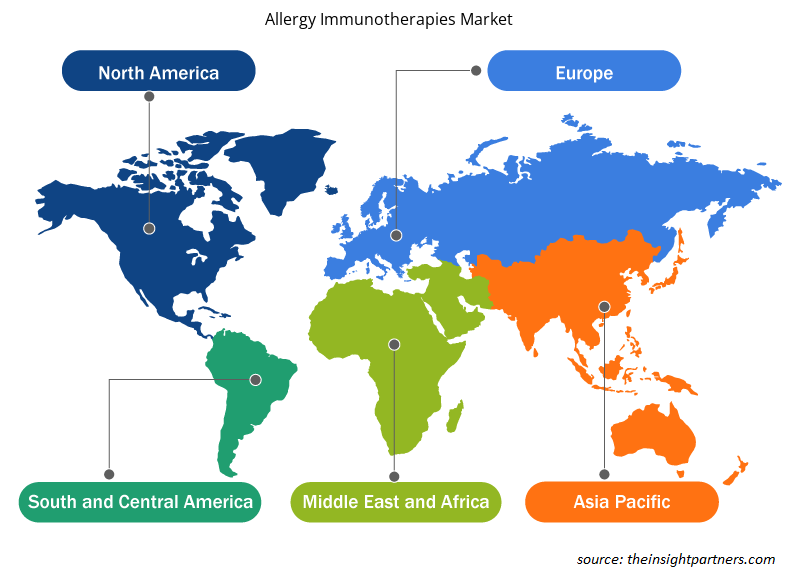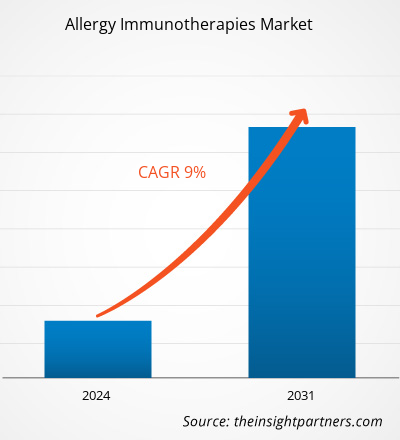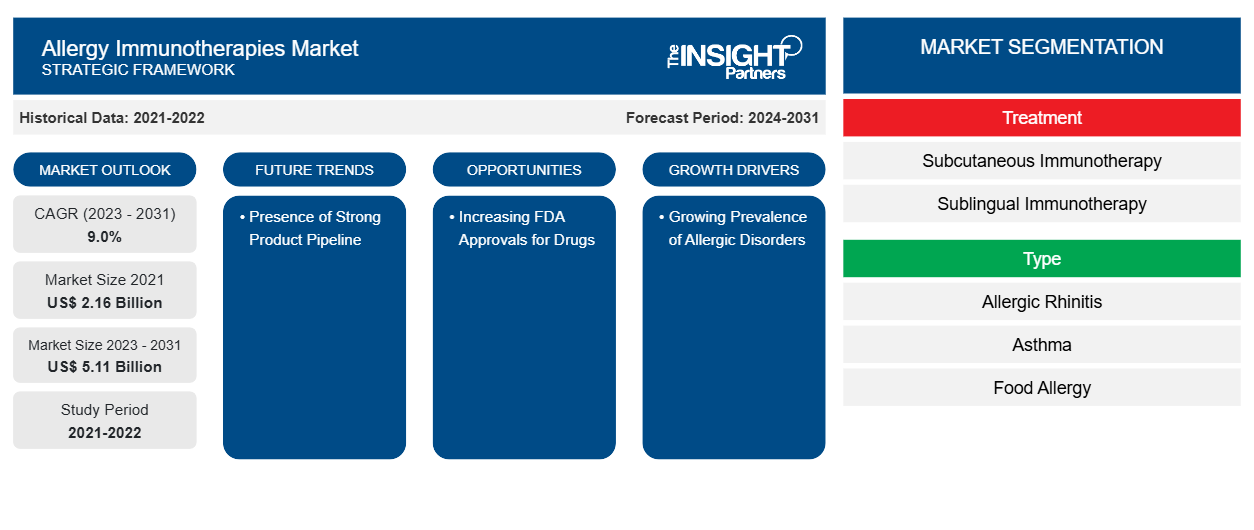Der Markt für Allergie-Immuntherapien wurde im Jahr 2021 auf 2,16 Milliarden US-Dollar und im Jahr 2023 auf xx Milliarden US-Dollar geschätzt. Bis 2031 dürfte er 5,11 Milliarden US-Dollar erreichen und bis 2031 eine durchschnittliche jährliche Wachstumsrate von 9,0 % verzeichnen. Die Entwicklung neuer Verabreichungsmethoden, der Anstieg von Kombinationstherapien und Fortschritte in der personalisierten Medizin werden voraussichtlich weiterhin die wichtigsten Trends auf dem Markt für Allergie-Immuntherapien bleiben.
Marktanalyse für Allergie-Immuntherapien
Die weltweit zunehmende Verbreitung allergischer Erkrankungen dürfte das Wachstum des Marktes für Allergie-Immuntherapien vorantreiben. Die zunehmende Verbreitung allergischer Erkrankungen erfordert eine Allergie-Immuntherapie, eine sichere und wirksame Behandlung gegen Allergene wie Insektenschimmel, Pollen und Tiere sowie gegen allergisches Asthma. Laut dem American College of Allergy, Asthma & Immunology gab im Jahr 2021 jeder dritte Erwachsene und über jedes vierte Kind in den USA an, an einer saisonalen Allergie, einem Ekzem oder einer Nahrungsmittelallergie zu leiden.
Die weltweit zunehmende Verbreitung von Allergien erhöht die globale Nachfrage nach Immuntherapien, was das Wachstum des Marktes begünstigt.
Marktübersicht für Allergie-Immuntherapien
Der globale Markt für Allergie-Immuntherapien ist nach Regionen unterteilt in Nordamerika, Europa, Asien-Pazifik, Naher Osten und Afrika sowie Süd- und Mittelamerika. Das Marktwachstum in dieser Region wird aufgrund von Faktoren wie der zunehmenden Verbreitung allergischer Erkrankungen und technologischen Fortschritten bei sublingualen Dosierungsformulierungen erwartet. Allerdings dürften Nachteile im Zusammenhang mit der Verwendung von Allergie-Immuntherapien und regulatorische Unterschiede zwischen den Regionen das Marktwachstum im Prognosezeitraum behindern.
Passen Sie diesen Bericht Ihren Anforderungen an
Sie erhalten kostenlos individuelle Anpassungen an jedem Bericht, einschließlich Teilen dieses Berichts oder einer Analyse auf Länderebene, eines Excel-Datenpakets sowie tolle Angebote und Rabatte für Start-ups und Universitäten.
-
Holen Sie sich die wichtigsten Markttrends aus diesem Bericht.Dieses KOSTENLOSE Beispiel umfasst eine Datenanalyse von Markttrends bis hin zu Schätzungen und Prognosen.
Markttreiber und Chancen für Allergie-Immuntherapien
Das wachsende Bewusstsein für die Allergiebehandlung dürfte dem Markt zugute kommen.
Das gestiegene öffentliche Bewusstsein für Allergien und ihre Behandlungsmöglichkeiten fördert die Nachfrage nach besseren Behandlungsmethoden. Menschen suchen nach Linderung von Symptomen, die ihre Lebensqualität erheblich beeinträchtigen können.
Das Office of the State Superintendent of Education (OSSE) und die Division of Health & Wellness feierten vom 14. bis 20. Mai 2023 die Food Allergy Awareness Week. Die Kampagne konzentrierte sich auf die Aufklärung und Sensibilisierung zum Thema Nahrungsmittelallergien und Anaphylaxie.OSSE) and the Division of Health & Wellness celebrated Food Allergy Awareness Week from May 14 to May 20, 2023. The campaign focused on educating and raising awareness about food allergies and anaphylaxis.
Vorhandensein einer starken Produktpipeline – eine Chance auf dem Markt für Allergie-ImmuntherapienImmunotherapies Market
Die Pipeline der Allergie-Immuntherapien besteht aus 15 Therapien in unterschiedlichen klinischen Entwicklungsstadien. Einige der an der Entwicklung von Immuntherapien für allergische Erkrankungen beteiligten Akteure sind Aimmune Therapeutics Inc., DBV Technologies SA, Genentech Inc., ASIT biotech SA, Inmunotek SL, Anergis SA, Biomay AG und Regeneron Pharmaceuticals Inc.immunotherapy pipeline consists of 15 therapies in different clinical stages of development. Some of the players involved in the development of immunotherapies for allergic diseases are Aimmune Therapeutics Inc., DBV Technologies S.A., Genentech Inc., ASIT biotech SA, Inmunotek SL, Anergis S.A., Biomay AG, and Regeneron Pharmaceuticals Inc.
Positive klinische Ergebnisse verschiedener Immuntherapien, die sich in klinischen Studien befinden, unterstützen die Entwicklung von Medikamenten auf der Basis von Allergie-Immuntherapien. So erteilte die Food and Drug Administration (FDA) im November 2022 dem ADP101 von Alladapt Immunotherapeutic den Status „Fast Track“ – einer experimentellen oralen Immuntherapie zur Behandlung eines oder mehrerer der wichtigsten Nahrungsmittelallergene
Marktbericht zu Allergie-Immuntherapien – Segmentierungsanalyse
Wichtige Segmente, die zur Ableitung der Marktanalyse für Allergie-Immuntherapien beigetragen haben, sind Dienstleistungen und Anwendungen.
- Basierend auf der Behandlung ist der Markt für Allergie-Immuntherapien in subkutane Immuntherapie (SCIT) und sublinguale Immuntherapie (SLIT) unterteilt. Im Jahr 2023 hielt das Segment der subkutanen Immuntherapie (SCIT) den größten Marktanteil. Darüber hinaus wird erwartet, dass das Segment der sublingualen Immuntherapie (SLIT) im Prognosezeitraum am schnellsten wächst.
- Nach Allergietyp ist der Markt für Allergie-Immuntherapien in allergische Rhinitis, Asthma, Nahrungsmittelallergie, Giftallergie und andere unterteilt. Das Segment allergische Rhinitis hatte im Jahr 2023 den größten Marktanteil, und es wird erwartet, dass dasselbe Segment im Prognosezeitraum die höchste durchschnittliche jährliche Wachstumsrate (CAGR) auf dem Markt verzeichnet.
- Der Markt für Allergie-Immuntherapien wurde nach Vertriebskanälen in Krankenhausapotheken, Einzelhandelsapotheken und Online-Apotheken segmentiert. Im Jahr 2023 hielt das Segment der Krankenhausapotheken den größten Marktanteil nach Vertriebskanälen. Darüber hinaus wird erwartet, dass dasselbe Segment im Prognosezeitraum am schnellsten wächst.
Marktanteilsanalyse für Allergie-Immuntherapien nach geografischer Lage
Der geografische Umfang des Marktberichts zu Allergie-Immuntherapien ist hauptsächlich in fünf Regionen unterteilt: Nordamerika, Asien-Pazifik, Europa, Naher Osten und Afrika sowie Südamerika/Süd- und Mittelamerika.
Zu Nordamerika gehören die USA, Kanada und Mexiko. Nordamerika hält den größten Anteil am Markt für Allergie-Immuntherapien, wobei die USA den größten Marktanteil haben, gefolgt von Kanada. Die USA halten den größten Anteil am Markt für Allergie-Immuntherapien, was auf die zunehmende Verbreitung von allergischen Erkrankungen zurückzuführen ist, wodurch die Nachfrage nach Allergie-Immuntherapien steigt und das Wachstum des Marktes vorangetrieben wird. Darüber hinaus sind viele Hersteller von Allergie-Immuntherapien dort ansässig, was das Wachstum des Marktes im Land weiter vorantreibt. Darüber hinaus hat das steigende Bewusstsein der Verbraucher in Bezug auf Allergiebehandlungen die Nachfrage nach medizinischem Zusatzsauerstoff in Nordamerika erhöht.
Der asiatisch-pazifische Raum wird voraussichtlich die am schnellsten wachsende Region unter allen anderen Regionen sein. Das Marktwachstum im asiatisch-pazifischen Raum wird voraussichtlich aufgrund von Faktoren wie der hohen Prävalenz von allergischen und immunologischen Erkrankungen in Ländern wie Australien, Indien und anderen schneller voranschreiten. Darüber hinaus wird erwartet, dass zunehmende Initiativen der Regierung in Bezug auf Präventions- und Behandlungsstrategien ein lukratives Marktwachstumsszenario in der Region schaffen werden. Darüber hinaus wird erwartet, dass der Ausbau der Gesundheitsinfrastruktur und zunehmende Investitionen zur Förderung der Forschungsaktivitäten den Markt für Allergie-Immuntherapien im asiatisch-pazifischen Raum im Prognosezeitraum ankurbeln werden.
Allergie-Immuntherapien
Regionale Einblicke in den Markt für Allergie-Immuntherapien
Die regionalen Trends und Faktoren, die den Markt für Allergie-Immuntherapien während des Prognosezeitraums beeinflussen, wurden von den Analysten von Insight Partners ausführlich erläutert. In diesem Abschnitt werden auch Marktsegmente und Geografie für Allergie-Immuntherapien in Nordamerika, Europa, im asiatisch-pazifischen Raum, im Nahen Osten und Afrika sowie in Süd- und Mittelamerika erörtert.

- Erhalten Sie regionale Daten zum Markt für Allergie-Immuntherapien
Umfang des Marktberichts zu Allergie-Immuntherapien
| Berichtsattribut | Details |
|---|---|
| Marktgröße im Jahr 2021 | 2,16 Milliarden US-Dollar |
| Marktgröße bis 2031 | 5,11 Milliarden US-Dollar |
| Globale CAGR (2023 - 2031) | 9,0 % |
| Historische Daten | 2021-2022 |
| Prognosezeitraum | 2024–2031 |
| Abgedeckte Segmente |
Nach Behandlung
|
| Abgedeckte Regionen und Länder |
Nordamerika
|
| Marktführer und wichtige Unternehmensprofile |
|
Dichte der Marktteilnehmer für Allergie-Immuntherapien: Auswirkungen auf die Geschäftsdynamik verstehen
Der Markt für Allergie-Immuntherapien wächst rasant, angetrieben durch die steigende Nachfrage der Endnutzer aufgrund von Faktoren wie sich entwickelnden Verbraucherpräferenzen, technologischen Fortschritten und einem größeren Bewusstsein für die Vorteile des Produkts. Mit steigender Nachfrage erweitern Unternehmen ihr Angebot, entwickeln Innovationen, um die Bedürfnisse der Verbraucher zu erfüllen, und nutzen neue Trends, was das Marktwachstum weiter ankurbelt.
Die Marktteilnehmerdichte bezieht sich auf die Verteilung der Firmen oder Unternehmen, die in einem bestimmten Markt oder einer bestimmten Branche tätig sind. Sie gibt an, wie viele Wettbewerber (Marktteilnehmer) in einem bestimmten Marktraum im Verhältnis zu seiner Größe oder seinem gesamten Marktwert präsent sind.
Die wichtigsten auf dem Markt für Allergie-Immuntherapien tätigen Unternehmen sind:
- ALK-Abelló A/S
- Nestlé Gesundheitswissenschaft
- LETIPharma
- Stallergenes Greer
- HAL Allergy BV
- Johnson & Johnson Services, Inc.
Haftungsausschluss : Die oben aufgeführten Unternehmen sind nicht in einer bestimmten Reihenfolge aufgeführt.

- Erhalten Sie einen Überblick über die wichtigsten Akteure auf dem Markt für Allergie-Immuntherapien
Marktnachrichten und aktuelle Entwicklungen zu Allergie-Immuntherapien
Der Markt für Allergie-Immuntherapien wird durch die Erhebung qualitativer und quantitativer Daten aus Primär- und Sekundärforschung bewertet, die wichtige Unternehmensveröffentlichungen, Verbandsdaten und Datenbanken umfassen. Im Folgenden finden Sie eine Liste der Entwicklungen auf dem Markt für Allergie-Immuntherapien und -Strategien:
- Im August 2020 übernahm Nestlé Health Science Aimmune Therapeutics. Aimmunes zugelassenes Therapeutikum Palforzia würde das Portfolio von Nestlé Health Science um die erste und einzige von der FDA zugelassene Behandlung erweitern, die dazu beitragen soll, die Häufigkeit und Schwere allergischer Reaktionen auf Erdnüsse bei Kindern zu verringern. (Quelle: Pressemitteilung des Unternehmens)
- Im September 2023 schloss Stallergenes Greer eine Vereinbarung mit Nestlé Health Science zur Nutzung der oralen Immuntherapie Palforzia gegen Erdnussallergie. (Quelle: Pressemitteilung des Unternehmens)
Marktbericht zu Allergie-Immuntherapien – Umfang und Ergebnisse
Der Bericht „Marktgröße und Prognose für Allergie-Immuntherapien (2021–2031)“ bietet eine detaillierte Analyse des Marktes, die die folgenden Bereiche abdeckt:
- Marktgröße und Prognose auf globaler, regionaler und Länderebene für alle wichtigen Marktsegmente, die im Rahmen des Projekts abgedeckt sind
- Marktdynamik wie Treiber, Beschränkungen und wichtige Chancen
- Wichtige Zukunftstrends
- Detaillierte PEST/Porters Five Forces- und SWOT-Analyse
- Globale und regionale Marktanalyse mit wichtigen Markttrends, wichtigen Akteuren, Vorschriften und aktuellen Marktentwicklungen
- Branchenlandschaft und Wettbewerbsanalyse, einschließlich Marktkonzentration, Heatmap-Analyse, prominenten Akteuren und aktuellen Entwicklungen
- Detaillierte Firmenprofile
- Historische Analyse (2 Jahre), Basisjahr, Prognose (7 Jahre) mit CAGR
- PEST- und SWOT-Analyse
- Marktgröße Wert/Volumen – Global, Regional, Land
- Branchen- und Wettbewerbslandschaft
- Excel-Datensatz
Aktuelle Berichte
Erfahrungsberichte
Grund zum Kauf
- Fundierte Entscheidungsfindung
- Marktdynamik verstehen
- Wettbewerbsanalyse
- Kundeneinblicke
- Marktprognosen
- Risikominimierung
- Strategische Planung
- Investitionsbegründung
- Identifizierung neuer Märkte
- Verbesserung von Marketingstrategien
- Steigerung der Betriebseffizienz
- Anpassung an regulatorische Trends























 Kostenlose Probe anfordern für - Markt für Allergie-Immuntherapien
Kostenlose Probe anfordern für - Markt für Allergie-Immuntherapien